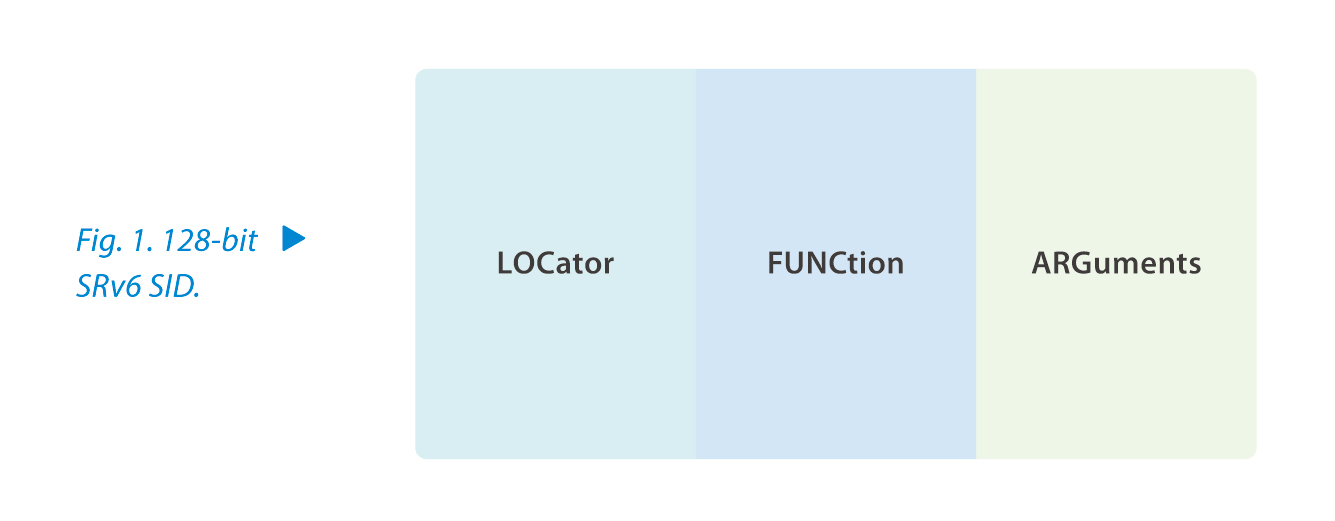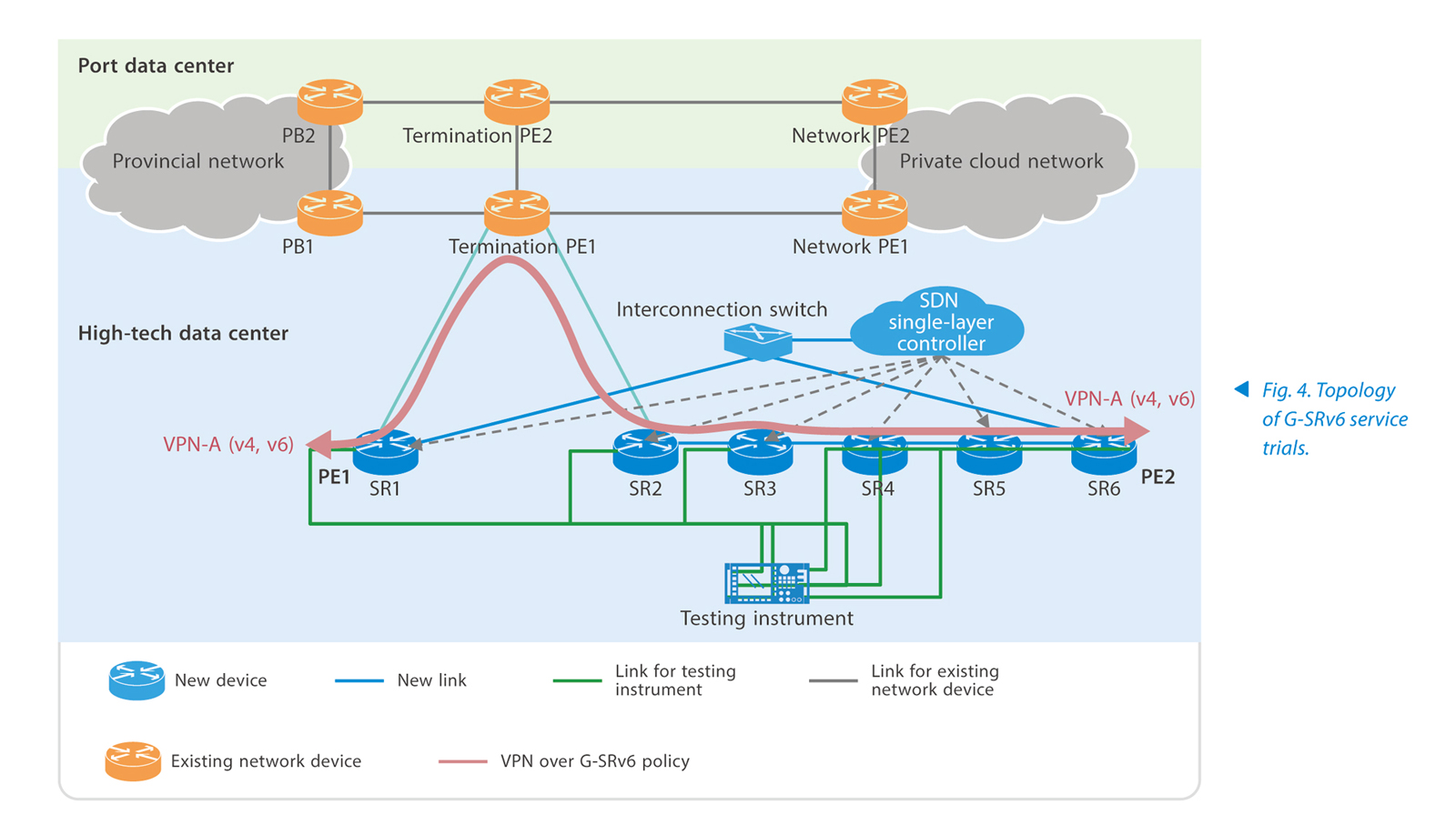ZTE, together with China Mobile and related vendors, innovatively launched the generalized segment routing over IPv6 (G-SRv6) header compression technology, completed multi-stage lab tests and deployment trials on the live network in Henan and Fujian provinces, and successfully verified its feasibility and large-scale deployment in 2020–2021. This marks a solid step towards formal G-SRv6 commercial deployment.
Background of SRv6 Head Compression
The segment ID (SID) of the standard SRv6 adopts 128-bit SID in IPv6 address format and consists of three parts: the LOC field that identifies the location of the node, the FUNC field that identifies services and functions, and the ARG field that stores related parameters (Fig. 1). Compared with the SID in MPLS label format, it has the routable attribute, which can simplify the creation of inter-domain paths and allow for end-to-end connection of the IPv6 network. The FUNC field supports programmability that can flexibly define network and service functions. Supported by network and service orchestrators, SRv6 can connect cloud-network paths and define services. This provides an excellent technical choice for cloud-network convergence and end-to-end service definition, so SRv6 has become the core technology of a new-generation IP transport network.

Despite the above advantages, the standard SRv6 still faces two major challenges in actual deployment. First, the overhead of SRv6 packets is high, and the bandwidth utilization of network links is low. The bandwidth utilization is only about 60% in the case of the 256-byte payload with 8 SIDs. Second, as SRv6 packet processing has high requirements for chips, it is difficult for a large number of devices in the existing network to support the replication and operation of deep SRH headers, which reduces the processing efficiency of existing chips. To address these issues, the segment routing header (SRH) compression of the standard SRv6 needs to be optimized.
Main Features of SRv6 Compression
The SRv6 compression technology adopts common prefix compression or mapping to optimize the SID length. The common prefix compression scheme is the mainstream choice at present.
SRH compression optimization needs to consider the following:
—Compatible with the standard SRv6: Maintain the existing SRH format to prevent packets from being discarded by the standard SRv6 node.
—Fixed SID compression length: Considering network scalability, byte alignment, compression efficiency and implementation difficulty, the SID compression length should be fixed as much as possible.
—Supporting original IPv6 address planning: The address planning of the compression scheme needs to be compatible with the current network address planning to avoid deployment failure or a waste of public network addresses.
A variety of 128-bit SID SRH compression optimization schemes have been proposed in the industry, and G-SRv6 is a typical one.
Principle of G-SRv6 Compression
The locator field in the legacy 128-bit SRv6 SID can be subdivided into B:N, where B identifies SRv6 SID block, which is generally allocated to a subnet by the operator, usually expressed by Prefix, and N is the identification used to distinguish nodes in the subnet.
In fact, many SIDs in one SRv6 network share a common prefix, and the common prefix in an SID list is redundant. Therefore, the common prefix and other redundant parts in the SRv6 SID are removed from the SID list, and node ID and function ID are kept as compression SID to reduce the overhead of packet headers. The compression SID is the generalized SID (G-SID) in the SRv6 header compression scheme, as shown in Fig. 2.
The G-SRv6 scheme uses 32-bit G-SID to represent the standard 128-bit SID and replace its encapsulation in the SRH header. Theoretically, one conventional SID space accommodates four G-SIDs, remarkably optimizing SRH encapsulation overhead of the standard SRv6.
Comparison between G-SRv6 and uSID
Many SRv6 compression schemes have gradually converged, and the recent voting in IETF SPRING WG has ended. The G-SRv6 scheme (G-SID) and CISCO's uSID, as a whole scheme C-SID, have been basically adopted as working group drafts.
The uSID scheme is similar to the above G-SID scheme. The basic principle is to extract the common block prefix. The difference is that G-SID stores the common prefix in DA, while uSID puts it in the uSID block of each 128-bit SID header (Fig. 3), and the uSID that follows is the compression tag.
The main restriction of the uSID scheme is that the block prefix has high requirements. In order to maintain high compression efficiency, the block length is often set to a 16-bit private network segment or a smaller 32-bit public network segment, which has more strict requirements for the operator's address planning.
Deployment Verification of G-SRv6 Related Technologies
From early 2020 to late 2021, China Mobile R&D Institute took the lead in formulating technical standards related to the G-SRv6 scheme, and verified the technical solutions in labs and deployment trials on existing networks in phases. As a core member, ZTE participated in the whole process, contributed some of the core technical features, and rapidly put them into production, which greatly promoted the development of G-SRv6.
Technical Verfication in Labs
—In the first phase of 2020, ZTE verified the feasibility of G-SRv6 technical framework, including basic forwarding plane and control plane tests that involved compression coding and forwarding of strict and loose policy paths in compressed intra-domain, inter-domain, and legacy SRv6 hybrid networking scenarios. The control plane contains a whole set of signaling flows such as ISIS protocol compression information distribution, BGP-LS sending controller, and BGP delivering policy compression path information.
—In the second phase of 2020, ZTE verified reliability technologies including intra-TI-LFA, anti-microloop, HSB, and round-trip same-path BFD, as well as active OAM, option A cross-domain reliability and OAM technologies.
Deployment Trials on Existing Networks
—In November 2020, ZTE completed a successful phase-1 G-SRv6 deployment trial on the existing network of China Mobile Henan Branch, and verified the interoperability between G-SRv6 forwarding and control planes. Taking VPN as basic service, it verified the deployment of G-SRv6 in different network combinations such as across common IPv6 networks or G-SRv6 compression domains, or across compression domains and common SRv6 domains, and analyzed the impact of G-SRv6 on existing network devices and services, the corresponding solutions, and the deployment feasibility. The topology of G-SRv6 service trials is shown in Fig. 4.

—In September 2021, ZTE successfully completed the phase-2 G-SRv6 deployment trial on the existing network of China Mobile Fujian Branch. It tested the application effect of multi-vendor router G-SRv6 back-to-back cross-domain deployment, reliability and O&M functions, verified the networking schemes and service application scenarios, and gradually promoted the maturity, deployment and commercialization of G-SRv6.
Follow-up Plan of G-SRv6
It is planned to conduct the third phase of technical verification in 2022, including hierarchical end-to-end cross-domain solutions and in-situ flow information telemetry (iFIT). Their commercial deployment will be carried out in the existing network in the second half of 2022.
With the trend of large-scale 5G deployment, digital transformation and cloud-network convergence, the G-SRv6 technology can activate a large number of existing networks, help operators quickly build digital intelligent networks, and empower thousands of industries. ZTE and China Mobile will continue to cooperate deeply to promote the large-scale deployment of G-SRv6, make the network intelligent and ultra-lean, and embrace the new 5G era.